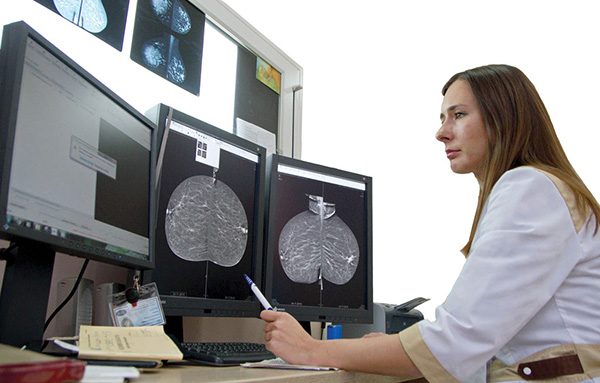In our modern times, we can send complicated cardiograms from a rural ambulance to a district cardiologist or consult with a leading medical establishment on serious neurological problems. Telemedicine enables doctors from geographically distant establishments to exchange data promptly, clarifying diagnosis. Belarus is the first in the CIS to make these innovations part of the daily work of medical employees.

Yulia Loboda, roentgenologist. In the roentgen-room of Minsk City Clinical Oncology Dispensary
In the past, similar professional medical consultations were available only in some districts of Gomel and Brest Regions: those which suffered most from the Chernobyl disaster. Today, the goal is to embrace all Republican centres, and around 70 percent of establishments specialising in endocrinology, oncology and the treatment of tuberculosis (phthisiology). Half of all district organisations will be involved, and telemedicine will expand its network in the field of mammography, to help diagnose breast cancer.
According to the Head Doctor of Minsk City Clinical Oncology Dispensary, Vladimir Karanik, seven Minsk polyclinics (equipped with mammographers) are at various stages of joining this network. By late 2015, the process should be operating smoothly. In line with requirements placed on breast screening, each mammogram result will be studied by two, independent radiologists, to avoid error.
Minsk polyclinic #34 has been the first to liaise with the City Clinical Oncology Dispensary; a pilot screening was launched two years ago. After a patient has had their mammogram, the radiologist sends the images to doctors at the Oncology Dispensary. To speed up data transfer, bilateral optic-fibre communication has been installed. When the project develops further, and other medical establishments gain access, the volume of such consultations will rise dramatically.
Telemedicine is being used for training of medical staff, video conferences and consulting — with the latter enjoying the major focus. According to Semen Polyakov, who heads the Organisational-Methodical and Systematic-Technical Accompaniment of Health Protection Information Department at the Republican Scientific-Practical Centre of Medical Technologies, Informatisation, Management and Health Protection, 85 percent of telemedicine developments revolve around ‘offline consulting’. Simply speaking, a doctor provides their colleague with all possible information and, if a case isn’t urgent, colleagues can use a computer database, connected to a special server, to draw their own conclusions.
Telemedicine is convenient in being able to draw on specialist expertise without such consultants being present at each clinic. A centralised server allows scrutiny of x-rays, which can be sent by a nurse at the push of a button, enabling clear, professional and prompt analysis.
By Anna Osokina











